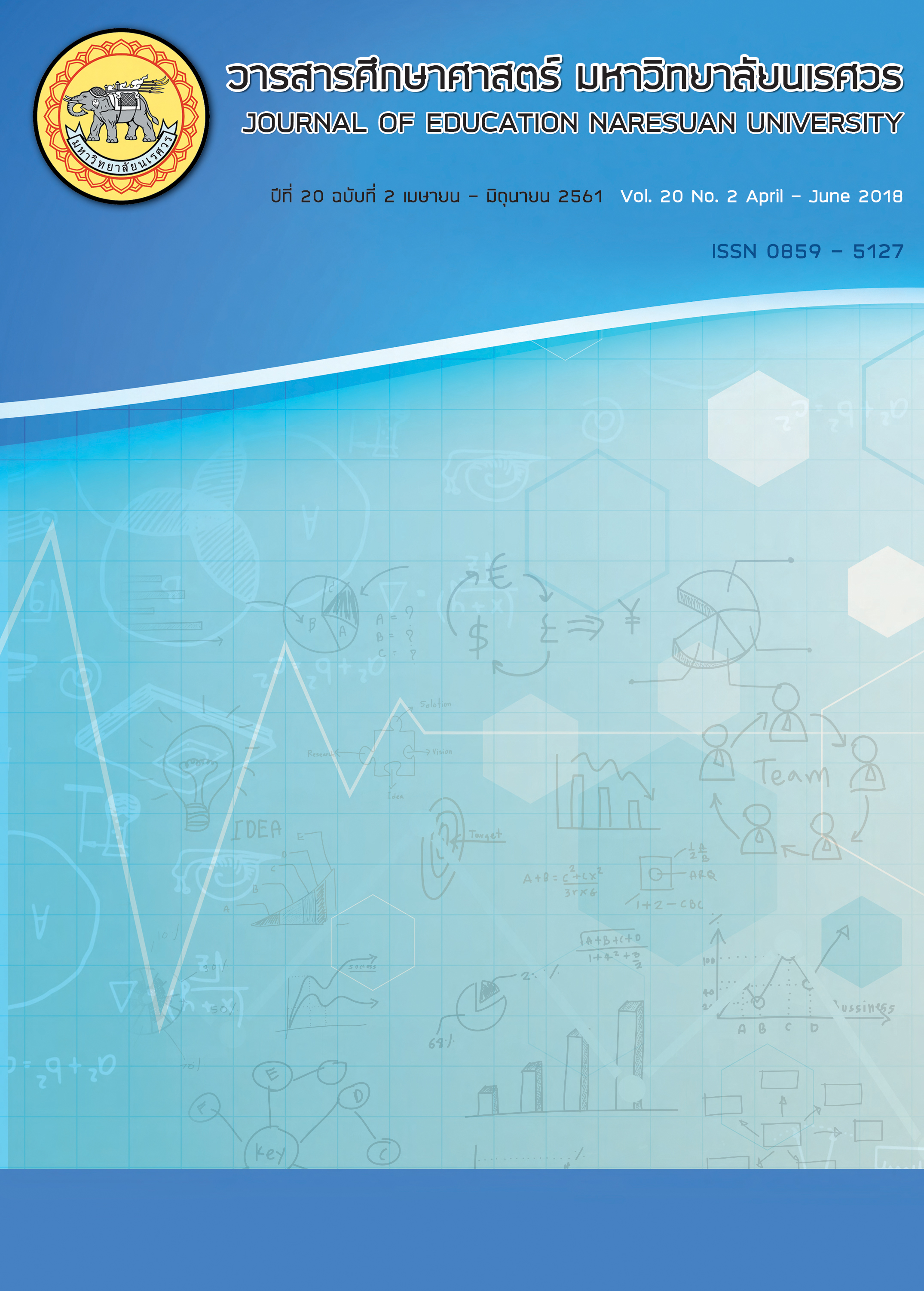การพัฒนาหลักสูตรฐานสมรรถนะด้านคุณลักษณะของบัณฑิตนักปฏิบัติ มหาวิทยาลัยเทคโนโลยีราชมงคลตะวันออก; THE CURRICULUM DEVELOPMENT OF COMPETENCY BASED ON ATTRIBUTES OF STUDENTS HANDS-ON RAJAMANGALA UNIVERSITY OF TECHNOLOGY TAWAN-OK
Main Article Content
Abstract
การวิจัยครั้งนี้มีวัตถุประสงค์เพื่อพัฒนาหลักสูตรฐานสมรรถนะด้านคุณลักษณะของบัณฑิตนักปฏิบัติ และเพื่อประเมินหลักสูตรฐานสมรรถนะด้านคุณลักษณะของบัณฑิตนักปฏิบัติของมหาวิทยาลัยเทคโนโลยีราชมงคลตะวันออก โดยผู้เชี่ยวชาญด้วยการใช้เทคนิคการวิเคราะห์แบบปุยแซงค์ โดยมีกระบวนการพัฒนาหลักสูตร 3 ขั้นตอน คือ 1) การศึกษาข้อมูลพื้นฐาน 2) การสร้างหลักสูตร และ 3) การประเมินคุณภาพหลักสูตร กลุ่มตัวอย่างที่ใช้ในการวิจัย ได้แก่ ผู้ผลิตบัณฑิตและผู้ใช้บัณฑิตของมหาวิทยาลัยเทคโนโลยีราชมงคลตะวันออก จำนวน 111 คน ได้จากการสุ่มอย่างง่าย (Simple Random Sampling) เครื่องมือที่ใช้ในการวิจัย ได้แก่ แบบสอบถามองค์ประกอบของสมรรถนะและคุณภาพบัณฑิต ด้านคุณลักษณะ และหลักสูตรฐานสมรรถนะด้านคุณลักษณะของบัณฑิตนักปฏิบัติ มหาวิทยาลัยเทคโนโลยีราชมงคลตะวันออก ประกอบด้วย 7 หน่วยการเรียนรู้ เวลา 30 ชั่วโมง สถิติที่ใช้ ได้แก่ ค่าความถี่ (Frequencies) และค่าร้อยละ (Percentage) ผลการวิจัย พบว่า
1. การศึกษาข้อมูลพื้นฐานเกี่ยวกับองค์ประกอบของสมรรถนะด้านคุณลักษณะตามที่ผู้ผลิตบัณฑิตและผู้ใช้บัณฑิตมุ่งหวังให้เกิดกับบัณฑิตมหาวิทยาลัยเทคโนโลยีราชมงคลตะวันออก พบว่า สมรรถนะในการปฏิบัติงานที่ต้องการให้มีในระดับมากที่สุด คือ สมรรถนะด้านคุณธรรมจริยธรรมในการทำงาน รองลงมา คือ สมรรถนะด้านการทำงานเป็นทีม สมรรถนะด้านการมุ่งผลสัมฤทธิ์ในการปฏิบัติงาน สมรรถนะด้านบุคลิกภาพ สมรรถนะด้านการสั่งสมความเชี่ยวชาญในงานอาชีพ สมรรถนะด้านทักษะการเป็นผู้นำ และสมรรถนะด้านการคิดวิเคราะห์ ตามลำดับ
2. ได้หลักสูตรฐานสมรรถนะด้านคุณลักษณะของบัณฑิตนักปฏิบัติของมหาวิทยาลัยเทคโนโลยีราชมงคลตะวันออก โดยมีองค์ประกอบของหลักสูตร 3 ส่วน ได้แก่ ส่วนที่ 1 หลักสูตร ฐานสมรรถนะด้านคุณลักษณะ ส่วนที่ 2 คู่มือการใช้หลักสูตร โดยจัดทำเป็นหน่วยการเรียนรู้ที่สามารถใช้เป็นเอกสารในการวางแผนการจัดกิจกรรมการเรียนรู้ จำนวน 7 หน่วยการเรียนรู้ ส่วนที่ 3 ใบความรู้ประกอบการบรรยายในแต่ละหน่วยการเรียนรู้จำนวน 7 หน่วยการเรียนรู้
3. ได้หลักสูตรฐานสมรรถนะด้านคุณลักษณะของบัณฑิตนักปฏิบัติของมหาวิทยาลัยเทคโนโลยีราชมงคลตะวันออก มีค่า P.M. เท่ากับ 11.04 แปลความหมายตามเกณฑ์การประเมินค่า P.M. ได้ว่าเป็นหลักสูตรที่มีคุณภาพสูงหรือดีมาก มีความเหมาะสมที่จะนำไปใช้ในการจัดการเรียนการสอนได้
THE CURRICULUM DEVELOPMENT OF COMPETENCY BASED ON ATTRIBUTES OF STUDENTS HANDS-ON RAJAMANGALA UNIVERSITY OF TECHNOLOGY TAWAN-OK
The purposes of this research was to develop the curriculum competency based on attributes of students hands-on and to evaluate curriculum competency based on attributes of students hands-on Rajamangala University of Technology Tawan-ok by experts with Puissance Analysis Technique. There were three steps for the curriculum development procedure; 1) background information study, 2) curriculum development, and 3) evaluation quality of curriculum. Simple Random Sampling was used in this research. The sample consisted of 111 graduates from Rajamangala university of Technology Tawan-ok and from the employers.
The instruments used for this research included; element questionnaire of competency and quality graduates on attributes and the curriculum competency based on attributes of students hands-on Rajamangala University of Technology consisted of seven units period of study in thirty hours. The data were statistically analyzed by frequencies and percentage. The results of the research were as follows:
1. The background information was about element of competency on attributes according to graduates and the employers expected to happen for graduates Rajamangala University of Technology Tawan-ok. The results found that the competency in practice that requires the highest level was morality and ethics to work with the competency, performance teamwork of competency, the achievement motivation of the operation of competency, the personality of competency, the gain expertise in various careers of competency, the leadership skills of competency and the critical thinking of competency, respectively.
2. The curriculum competency based on attributes of students hands-on, Rajamangala University of Technology Tawan-ok. The elements of the curriculum consisted of three components; part 1: The curriculum competency based on attributes, part 2: Curriculum Manual Program which was the unit plant used for preparing document in planning learning activities of 7 learning units, and part 3: The knowledge presented in each of 7 learning units.
3. The curriculum competency based on attributes of students hands -on Rajamangala University of Technology Tawan-ok rated the Puissance measure 11.04. Interpretation on the basis of valuation P.M. was high quality or very good. Also the curriculum could be applied for the teaching and learning.
Article Details
The owner of the article does not copy or violate any of its copyright. If any copyright infringement occurs or prosecution, in any case, the Editorial Board is not involved in all the rights to the owner of the article to be performed.
References
Khumpradit, O., Jansila, V., Mejang, S., & Saisang, P. (2014). The competency development model for the managerial head of educational service unit in thailand community college. Journal of Education Naresuan University, 16(3), 107-119. (in Thai)
Louw, L., Bosch, J. K., & Venter, D. J. (2001). Quality perceptions of MBA courses and required management competencies. Quality Assurance in education, 9(2), 72-80.
Ministry of Education. (2009). Thai qualifications framework for higher education B.E. 2552 (2009). Bangkok: Ministry of Education Announcement. (in Thai)
National Statistical Office & Office of the Public Sector Development Commission.
(2014). Reports satisfaction surveys, user satisfaction and ggraduate students for the year B.E. 2556 (2013) Rajamangala University of Technology Tawan-ok. Bangkok: National Statistical Office & Office of the Public Sector Development Commission. (in Thai)
Nawsuwan, K., & Singhasame, P. (2014). Thai graduate characteristics toward asean community. Journal of Humanities and Social Sciences Mahasarakham University, 30(5), 212-222. (in Thai)
Nidapoll. (2014). The public opinion survey on problems with Thai graduate quality. Bangkok: National Institute of Development Administration. (in Thai)
Office of the Education Council. (2013). National qualifications framework. Bangkok: Prigwhan Graphic. (in Thai)
Pawchit, C. (2011). Competency and quality of economics graduates desired by employers. Bangkok: National Research Council of Thailand. (in Thai)
Phuphan, S. (2003). Basic concepts of curriculum creation and development. Chiang Mai: Sangsilp Printing House. (in Thai)
Praphanphat, T. (2011). Development of an industrial professional experience training program for students of Industrial Technology Rajamangala University of Technology (Doctoral Dissertation). Bangkok: Silpakorn University. (in Thai)
Standard Institute of Higher Education. (2011). Government gazette. pp. 44-46. (in Thai)
Thianboocha, A. (2009). The development of key competencies in preparing employees for workplaces (Doctoral Dissertation). Bangkok: King Mongkut’s University of Technology North Bangkok. (in Thai)
Tongkeo, T. (2008). Competency: Principles and practices. Retrieved June 17, 2008, from https://www.dusithost.dusit.ac.th-ei/tuan/file21122005046.doc (in Thai)
Yurarach, S. (2011). The Readiness of the development of graduates in the private higher education institutions in Thailand to support the asean economic community. In Proceedings of the 15th National Symposium on Education Research (pp. 188-197). Bangkok: Eleven Star Intergrade. (in Thai)


